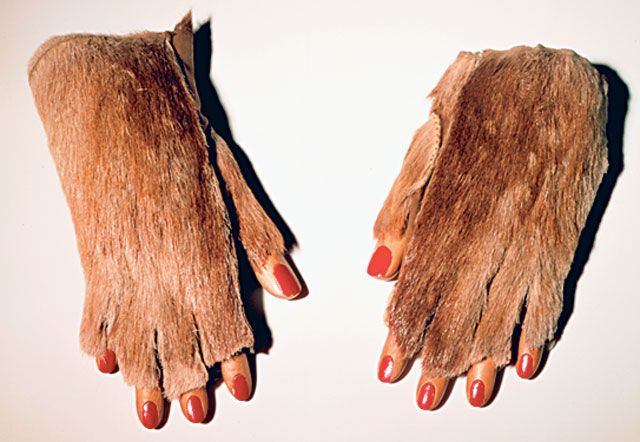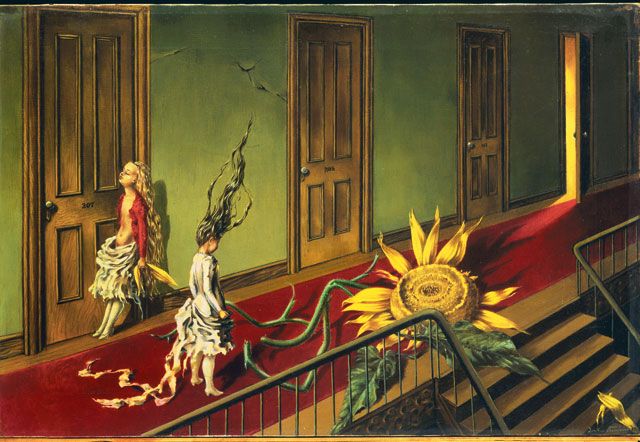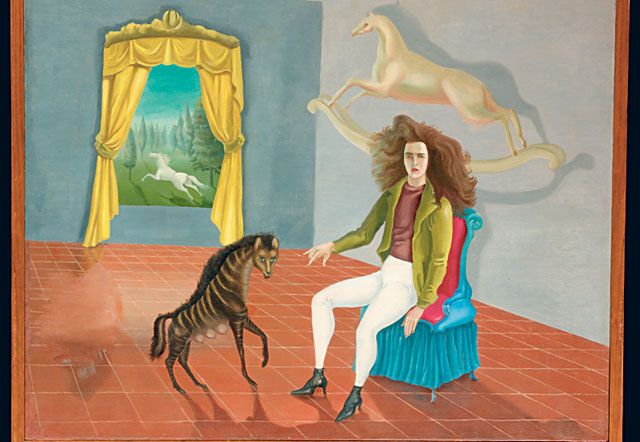While the Second World War was raging through Europe, United States Vogue's top model Lee Miller marched up to her editor and demanded: "I want to be your war correspondent."
The cover girl and Surrealist photographer, whose works feature in Angels of Anarchy, an exhibition under way in the United Kingdom, was Vogue's first — and only — war reporter.
Embedded with the US army, Miller photographed piles of bodies in concentration camps, the devastation of the London Blitz and the horrors of warfare. On the night Hitler committed suicide, she got into his lodgings and photographed herself in his bath, her army boots blackening his bath mat with dirt from his death camps.
Miller is among the group of women Surrealists featuring in the exhibition who fought gender roles in art as in life and rushed into places where all but "angels of anarchy" would fear to tread.
They sewed anti-Nazi messages into Nazi uniforms, photographed severed breasts on a plate to protest against the objectification of women and painted each other as artists at a time when women were usually seen on but not in front of a canvas.
Yet, despite being some of the most fearless and provocative artists of their time, the names of these women — such as Leonora Carrington, Dorothea Tanning, Eileen Agar, Leonor Fini — are almost unknown.
Following years of being underrepresented in exhibitions, art discourse and the public eye, Angels of Anarchy — the first major exhibition of women Surrealists in Europe — is fighting to redress this imbalance. It will give space to artists who formed part of the original Surrealist movement in the 1920s and 1930s, and more recent and rarely exhibited artists, including Francesca Woodman and Penny Slinger.
There are paintings by Carrington, an original member of the Surrealist movement, who, decades later, continues to dream up fantastical monsters, mythical creatures and living furniture in Mexico City.
Her portrait of herself as a young woman at her old English aristocratic home will be shown alongside her later El Mundo Magico de los Mayas, inspired by Mexican mythology, painted almost 30 years later.
Alongside older artists are those such as Penny Slinger, who discovered Surrealism much later in the century.
Slinger wrote her dissertation on Surrealist artist Max Ernst, helped by Miller and Roland Penrose of the original movement. Her painting I Hear What you Say of an ear in a mouth and Read My Lips of a vagina in a mouth, both from 1973, are shown for the first time at this exhibition.
Despite spanning decades, the women's works appear as a unified body of art with themes running through it as they have drawn inspiration from each other.
The still life of melons in Frida Kahlo's Naturaleza muerta con perico y bandera (1951) is mirrored 25 years later in Francesca Woodman's portrait of a woman whose breasts are substituted with melons.
If the Surrealists are celebrated for their daring subversion, the women Surrealists must be recognised for going a step further by pushing gender boundaries and subverting conventional female roles.
They were artists at a time when women were much more likely to be housewives than war reporters and were more often the subject of paintings than artists themselves.
"They were regarded as muses and objects of pleasure and inspiration rather than as artists," Miller's son Antony Penrose says.
For example, in the 1930s Miller was better known as a fashion icon than a photographer. She appeared regularly on the pages of Vogue.
But women Surrealists used their art to challenge this kind of objectification.
One day Miller was at a surgery where a mastectomy had just been performed.
She asked if she could take the severed breasts and ran straight to the Vogue studios where she put them on two plates and set a table around them as if they were to be served for dinner. Miller managed to photograph them before she and the breasts were thrown out by horrified Vogue staff.
Through the photographs Miller seemed to be saying to the society, "You like breasts? Have some on a plate."
Even the male Surrealists were guilty of excluding or objectifying female artists. The husbands and lovers of the artists, who included Max Ernst, Paul Eluard, André Breton, Man Ray and Pablo Picasso, kept much of their work out of Surrealist exhibitions.
"Surrealism was about breaking boundaries and divisions, which was a revolutionary notion," says exhibition curator Patricia Allmer. "The problem was that the male Surrealists did not quite push it as far as they should have, to include the gender boundary between women and men." Miller's son Penrose agrees. "The Surrealists had a blind spot when it came to women's equality," he says. In countless Surrealist works, women appear in dismembered forms, their heads in cages.
Arms and breasts appear without their bodies, affirming the idea that women are objects and sources of inspiration for artists rather than individuals.
But the women Surrealists used their art to rebel against this inequality.
They subverted the subversion genre to make nonsense of the Surrealist view of women, to make room for their identities.
Mimi Parent's Maitresse, for example, is a whip made up of two lopped off plaits of golden hair.
It takes a symbol of romanticised femininity, similar to those served up by male Surrealists and transforms it into a weapon: in control and in charge of its sexuality.
Paintings of women in cages by artists such as Ernst and Ray are similarly ridiculed in La Peret de Memoire by Josette Exandeier in which the head of a man is placed in a cage instead.
Frida Kahlo's portrait of herself and domineering artist husband Diego Rivera, Diego y Frida, is set within an utterly feminine pink pearly border, putting him entirely within her own framework.
But these women didn't simply subvert male ideas of femininity; they reclaimed them, making them their own.
In a room of portraits of women artists by other women artists, many present their subjects as elegant and fashion-conscious, sometimes even with their nails painted red. In Dora Maar's photographic portrait, her subject Nusch Eluard displays her delicate fingers adorned with a huge Lalique ring.
Miller's portraits of her artist friends Tanning, Fini and Carrington capture their grace and femininity.
"What these artists are saying is that actually you can be whatever you want to be, not in a capitalist sense, not in a light-hearted sense but at a very fundamental level," Allmer says.
"It can be very difficult for women to negotiate the space between all sorts of things such as ‘How can I be erotic yet not exploited?' This whole notion about ‘chill out, you can be whatever you want to be, you can take on certain aspects of our culture, leave others behind' comes through very strongly through these works."
Because much of the women Surrealists' work is unknown, while Salvador Dali, Ernst and Picasso now seem familiar and part of the art establishment, the work of women Surrealists still appears fresh and daring.
"I hope it will be like when people went to the original Surrealism exhibitions, when suddenly everything was unknown and disconcerting, with people thinking, ‘I'm not familiar with these works, I'm not sure how to react'," Allmer says.
"We know now how to react to Dali but with these artists there is something new."
But if these women tried so hard to assert their identities and make their voices heard, and only few people know their art, have they failed? "No," Allmer says. "Because 70 years later there are people such as myself and a very dedicated group of researchers who don't let go of and are still obsessed with their art and fighting for it to be seen."
Perhaps this exhibition of women Surrealists will create awareness about their work and lead to the artists at last gaining the recognition they deserve.
"The No 1 question I hope people will ask themselves when they see this exhibition is: ‘Why haven't I seen these artists before?' How do we exclude people without even noticing they're being excluded?" Allmer asks.
"My hope is that one day I'll be able to walk down the street and be able to say the names Agar, Carrington and Miller and as many people will know their names as Ray, Ernst and Dali. I think it will happen," Penrose says.
Rachel Rickard Straus is an independent writer based in the United Kingdom.














